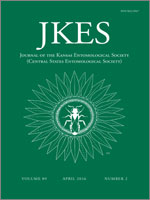In North America, brood parasitic bees of the genus Coelioxys attack nests of solitary nest-provisioning bees of the genus Megachile. Using trap-nests in central New York State, we found Coelioxys modesta (Smith) in 49% of 72 nests and 27% of 313 cells provisioned by Megachile campanulae (Robertson). Because we had a nearly complete record of the species and sex of individuals developing in nest cells, we were able to use logistic regression to test several hypotheses concerning the risk of brood parasitism, the spatial distribution of infested cells, and the sex and size of C. modesta at different cell positions. The probabilities that a nest was infested or contained multiple C. modesta were higher in nests of larger diameter and in those had been active for longer durations. Cells of the host and cells infested with C. modesta tended to cluster with those of conspecifics within nests, an observation consistent with the hypothesis that individual female C. modesta remain at or frequently revisit individual host nests in which they have already oviposited. One nest contained a string of six consecutive cells attacked by C. modesta. As is typical of cavity-nesting Megachile, M. campanulae female offspring tended to predominate in inner cells of nests. Because the risk of attack by C. modesta was unrelated to cell position, however, M. campanulae offspring sex ratio did not differ between infested and uninfested nests. Brood parasites within inner nest cells were more likely to be Females. Males in inner cells tended to be above average in body size, probably as a result of inner cells containing larger pollen masses. A review of studies of Coelioxys brood parasitism of Megachile revealed that the percent of M. campanulae nests infested in our study is one of the highest published values.
How to translate text using browser tools
1 April 2016
Brood Parasitism of the Resin Bee Megachile campanulae (Robertson) by Coelioxys modesta Smith (Hymenoptera: Megachilidae)
Kevin M. O’Neill,
James F. O’Neill
ACCESS THE FULL ARTICLE
Apoidea
body size
cavity-nesting
sex ratio
solitary bee
trap-nest





